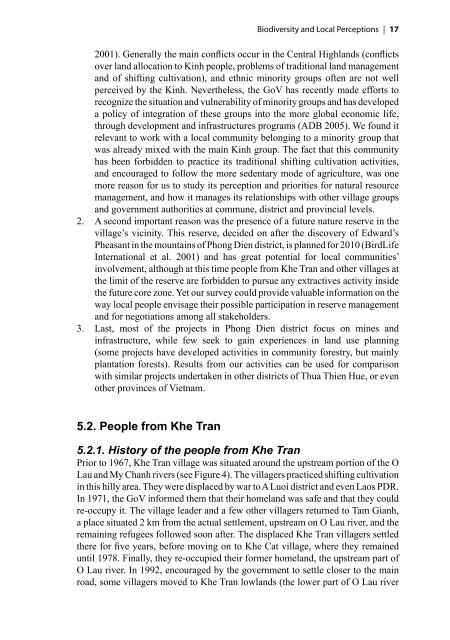English 2.28MB - Center for International Forestry Research
English 2.28MB - Center for International Forestry Research
English 2.28MB - Center for International Forestry Research
You also want an ePaper? Increase the reach of your titles
YUMPU automatically turns print PDFs into web optimized ePapers that Google loves.
Biodiversity and Local Perceptions |<br />
2001). Generally the main conflicts occur in the Central Highlands (conflicts<br />
over land allocation to Kinh people, problems of traditional land management<br />
and of shifting cultivation), and ethnic minority groups often are not well<br />
perceived by the Kinh. Nevertheless, the GoV has recently made ef<strong>for</strong>ts to<br />
recognize the situation and vulnerability of minority groups and has developed<br />
a policy of integration of these groups into the more global economic life,<br />
through development and infrastructures programs (ADB 2005). We found it<br />
relevant to work with a local community belonging to a minority group that<br />
was already mixed with the main Kinh group. The fact that this community<br />
has been <strong>for</strong>bidden to practice its traditional shifting cultivation activities,<br />
and encouraged to follow the more sedentary mode of agriculture, was one<br />
more reason <strong>for</strong> us to study its perception and priorities <strong>for</strong> natural resource<br />
management, and how it manages its relationships with other village groups<br />
and government authorities at commune, district and provincial levels.<br />
2. A second important reason was the presence of a future nature reserve in the<br />
village’s vicinity. This reserve, decided on after the discovery of Edward’s<br />
Pheasant in the mountains of Phong Dien district, is planned <strong>for</strong> 2010 (BirdLife<br />
<strong>International</strong> et al. 2001) and has great potential <strong>for</strong> local communities’<br />
involvement, although at this time people from Khe Tran and other villages at<br />
the limit of the reserve are <strong>for</strong>bidden to pursue any extractives activity inside<br />
the future core zone. Yet our survey could provide valuable in<strong>for</strong>mation on the<br />
way local people envisage their possible participation in reserve management<br />
and <strong>for</strong> negotiations among all stakeholders.<br />
3. Last, most of the projects in Phong Dien district focus on mines and<br />
infrastructure, while few seek to gain experiences in land use planning<br />
(some projects have developed activities in community <strong>for</strong>estry, but mainly<br />
plantation <strong>for</strong>ests). Results from our activities can be used <strong>for</strong> comparison<br />
with similar projects undertaken in other districts of Thua Thien Hue, or even<br />
other provinces of Vietnam.<br />
5.2. People from Khe Tran<br />
5.2.1. History of the people from Khe Tran<br />
Prior to 1967, Khe Tran village was situated around the upstream portion of the O<br />
Lau and My Chanh rivers (see Figure 4). The villagers practiced shifting cultivation<br />
in this hilly area. They were displaced by war to A Luoi district and even Laos PDR.<br />
In 1971, the GoV in<strong>for</strong>med them that their homeland was safe and that they could<br />
re-occupy it. The village leader and a few other villagers returned to Tam Gianh,<br />
a place situated 2 km from the actual settlement, upstream on O Lau river, and the<br />
remaining refugees followed soon after. The displaced Khe Tran villagers settled<br />
there <strong>for</strong> five years, be<strong>for</strong>e moving on to Khe Cat village, where they remained<br />
until 1978. Finally, they re-occupied their <strong>for</strong>mer homeland, the upstream part of<br />
O Lau river. In 1992, encouraged by the government to settle closer to the main<br />
road, some villagers moved to Khe Tran lowlands (the lower part of O Lau river

















